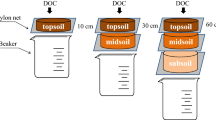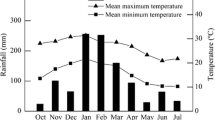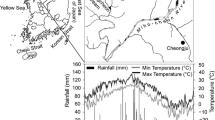Abstract
Decomposition of leaf litter and its incorporation into the mineral soil are key components of the C cycle in forest soils. In a 13C tracer experiment, we quantified the pathways of C from decomposing leaf litter in calcareous soils of a mixed beech forest in the Swiss Jura. Moreover, we assessed how important the cold season is for the decomposition of freshly fallen leaves. The annual C loss from the litter layer of 69–77% resulted mainly from the C mineralization (29–34% of the initial litter C) and from the transfer of litter material to the deeper mineral soil (>4 cm) by soil fauna (30%). Although only 4–5% of the initial litter C was leached as dissolved organic carbon (DOC), this pathway could be important for the C sequestration in soils in the long term: The DOC leached from the litter layer was mostly retained (95%) in the first 5 cm of the mineral soil by both physico-chemical sorption and biodegradation and, thus, it might have contributed significantly to the litter-derived C recovered in the heavy fraction (>1.6 g cm−3) at 0–4 cm depth (4% of the initial litter C). About 80% of the annual DOC leaching from the litter layer occurred during the cold season (Nov–April) due to an initial DOC flush of water-soluble substances. In contrast, the litter mineralization in winter accounted for only 25% of the annual C losses through CO2 release from the labelled litter. Nevertheless, the highest contributions (45–60%) of litter decay to the heterotrophic soil respiration were observed on warm winter days when the mineral soil was still cold and the labile litter pool only partly mineralized. Our 13C tracing also revealed that: (1) the fresh litter C only marginally primed the mineralization of older SOM (>1 year); and (2) non-litter C, such as throughfall DOC, contributed significantly to the C fluxes from the litter layer since the microbial biomass and the DOC leached from the litter layer contained 20–30% and up to 60% of unlabelled C, respectively. In summary, our study shows that significant amounts of recent leaf litter C (<1 year) are incorporated into mineral soils and that the cold season is clearly less important for the litter turnover than the warm season in this beech forest ecosystem.








Similar content being viewed by others
References
Bird JA, Torn MS (2006) Fine roots vs. needles: a comparison of 13C and 15N dynamics in a ponderosa pine forest soil. Biogeochem 79:361–382. doi:10.1007/s10533-005-5632-y
Bonkowski M, Scheu S, Schaefer M (1998) Interactions of earthworms (Octolasion lacteum), millipedes (Glomeris marginata) and plants (Hordelymus europaeus) in a beechwood on a basalt hill: implications for litter decomposition and soil formation. Appl Soil Ecol 9:161–166. doi:10.1016/S0929-1393(98)00070-5
Borken W, Davidson EA, Savage K, Gaudinski J, Trumbore SE (2003) Drying and wetting effects on carbon dioxide release from organic horizons. Soil Sci Soc Am J 67:1888–1896. doi:10.2136/sssaj2003.1888
Brookes PC, Landman A, Pruden G, Jenkinson DS (1985) Chloroform fumigation and the release of soil nitrogen: a rapid direct extraction method to measure microbial biomass in soil. Soil Biol Biochem 17:837–842
Cisneros-Dozal LM, Trumbore S, Hanson PJ (2006) Partitioning sources of soil-respired CO2 and their seasonal variation using a unique radiocarbon tracer. Glob Change Biol 12:194–204. doi:10.1111/j.1365-2486.2005.01061.x
Conant RT, Drijber RA, Haddix ML, Parton WJ, Paul EA, Plante AF, Six J, Steinweg JM (2008) Sensitivity of organic matter decomposition to warming varies with its quality. Glob Change Biol 14:868–877. doi:10.1111/j.1365-2486.2008.01541.x
Craine JM, Fierer N, McLauchlan KK (2010) Widespread coupling between the rate and temperature sensitivity of organic matter decay. Nat Geosci 3(12):854–857. doi:10.1038/NGEO1009
Dilling J, Kaiser K (2002) Estimation of the hydrophobic fraction of dissolved organic matter in water samples using UV photometry. Water Res 36:5037–5044. doi:10.1016/S0043-1354(02)00365-2
Etzold S, Buchmann N, Eugster W (2010) Contribution of advection to the carbon budget measured by eddy covariance at a steep mountain slope forest in Switzerland. Biogeosciences 7:2461–2475. doi:10.5194/bg-7-2461-2010
Fang C, Moncrieff JB (2001) The dependence of soil CO2 efflux on temperature. Soil Biol Biochem 33:155–165. doi:10.1016/S0038-0717(00)00125-5
Fierer N, Craine JM, McLauchlan K, Schimel JP (2005) Litter quality and the temperature sensitivity of decomposition. Ecology 86:320–326
Fontaine S, Mariotti A, Abbadie L (2003) The priming effect of organic matter: a question of microbial competition? Soil Biol Biochem 35:837–843. doi:10.1016/S0038-0717(03)00123-8
Fontaine S, Barot S, Barré P, Bdioui N, Mary B, Rumpel C (2007) Stability of organic carbon in deep soil layers controlled by fresh carbon supply. Nature 450:277–280. doi:10.1038/nature06275
Fröberg M, Berggren Kleja D, Hagedorn F (2007) The contribution of fresh litter to dissolved organic carbon leached from a coniferous forest floor. Eur J Soil Sci 58:108–114. doi:10.1111/j.1365-2389.2006.00812.x
Fröberg M, Hanson PJ, Trumbore SE, Swanston CW, Todd DE (2009) Flux of carbon from 14C-enriched leaf litter throughout a forest soil mesocosm. Geoderma 149:181–188. doi:10.1016/j.geoderma.2008.11.029
Hagedorn F, Machwitz M (2007) Controls on dissolved organic matter leaching from forest litter grown under elevated atmospheric CO2. Soil Biol Biochem 39:1759–1769. doi:10.1016/j.soilbio.2007.01.038
Hagedorn F, Maurer S, Bucher JB, Siegwolf RTW (2005) Immobilization, stabilization and remobilization of nitrogen in forest soils at elevated CO2: a 15N and 13C tracer study. Glob Change Biol 11:1816–1827. doi:10.1111/j.1365-2486.2005.01041.x
Hagedorn F, van Hees PAW, Handa IT et al (2008) Elevated atmospheric CO2 fuels leaching of old dissolved organic matter at the alpine treeline. Glob Biogeochem Cycl 22:GB2004. doi:10.1029/2007GB003026
Hansson K, Berggren Kleja D, Kalbitz K, Larsson H (2010) Amounts of carbon mineralised and leached as DOC during decomposition of Norway spruce needles and fine roots. Soil Biol Biochem 42:178–185. doi:10.1016/j.soilbio.2009.10.013
Hättenschwiler S, Bühler S, Körner C (1999) Quality, decomposition and isopod consumption of tree litter produced under elevated CO2. Oikos 85:271–281
Heim A, Frey B (2004) Early stage litter decomposition rates for Swiss forests. Biogeochem 70:299–313. doi:10.1007/s10533-003-0844-5
Heim A, Wehrli L, Eugster W, Schmidt MWI (2009) Effects of sampling design on the probability to detect soil carbon stock changes at the Swiss Carbo Europe site Lägeren. Geoderma 149:347–354. doi:10.1016/j.geoderma.2008.12.018
IUSS Working Group WRB (2007) World reference base for soil resources 2006. World Soil Resources Reports No. 103. FAO, Rome
Jansson PE, Karlberg L (2001) Coupled heat and mass transfer model for soil-plant-atmosphere systems. ftp://www.lwr.kth.se/CoupModel/CoupModel.pdf. Accessed 22 Sept 2009
Joos O, Hagedorn F, Heim A, Gilgen AK, Schmidt MWI, Siegwolf RTW, Buchmann N (2010) Summer drought reduces total and litter-derived soil CO2 effluxes in temperate grassland—clues from a 13C litter addition experiment. Biogeosciences 7:1031–1041. doi:10.5194/bg-7-1031-2010
Kaiser K, Guggenberger G (2000) The role of DOM sorption to mineral surfaces in the preservation of organic matter in soils. Org Geochem 31:711–725. doi:10.1016/S0146-6380(00)00046-2
Kaiser K, Guggenberger G (2007) Distribution of hydrous aluminium and iron over density fractions depends on organic matter load and ultrasonic dispersion. Geoderma 140:140–146. doi:10.1016/j.geoderma.2007.03.018
Kalbitz K, Kaiser K (2008) Contribution of dissolved organic matter to carbon storage in forest mineral soils. J Plant Nutr Soil Sci 171:52–60. doi:10.1002/jpln.200700043
Kalbitz K, Schmerwitz J, Schwesig D, Matzner E (2003) Biodegradation of soil-derived dissolved organic matter as related to its properties. Geoderma 113:273–291. doi:10.1016/S0016-7061(02)00365-8
Kammer A, Hagedorn F, Shevchenko I, Leifeld J, Guggenberger G, Goryacheva T, Rigling A, Moiseev P (2009) Treeline shifts in the Ural mountains affect soil organic matter dynamics. Glob Change Biol 15:1570–1583. doi:10.1007/s10533-010-9562-y
Kramer C, Trumbore S, Fröberg M, Cisneros Dozal LM, Zhang D, Xu X, Santos GM, Hanson PJ (2010) Recent (<4 year old) leaf litter is not a major source of microbial carbon in a temperate forest mineral soil. Soil Biol Biochem 42:1028–1037. doi:10.1016/j.soilbio.2010.02.021
Kuzyakov Y, Friedel JK, Stahr K (2000) Review of mechanisms and quantification of priming effects. Soil Biol Biochem 32:1485–1498. doi:10.1016/S0038-0717(00)00084-5
LeMellec A, Meesenburg H, Michalzik B (2010) The importance of canopy-derived dissolved and particulate organic matter (DOM and POM)—comparing throughfall solution from broadleaved and coniferous forests. Ann For Sci 67. doi:10.1051/forest/2009130
Liski J, Nissinen A, Erhard M, Taskinen O (2003) Climatic effects on litter decomposition from arctic tundra to tropical rainforest. Glob Change Biol 9:1–10. doi:10.1046/j.1365-2486.2003.00605.x
Liski J, Palosuo T, Peltoniemi M, Sievänen R (2005) Carbon and decomposition model Yasso for forest soils. Ecol Model 189:168–182. doi:10.1016/j.ecolmodel.2005.03.005
Magill AH, Aber JD (2000) Dissolved organic carbon and nitrogen relationships in forest litter as affected by nitrogen deposition. Soil Biol Biochem 32:603–613. doi:10.1016/S0038-0717(99)00187-X
Moore TR, Trofymow JA, Taylor B et al (1999) Litter decomposition rates in Canadian forests. Glob Change Biol 5:75–82. doi:10.1046/j.1365-2486.1998.00224.x
Müller M, Alewell C, Hagedorn F (2009) Effective retention of litter-derived dissolved organic carbon in organic layers. Soil Biol Biochem 41(6):1066–1074. doi:10.1016/j.soilbio.2009.02.007
Neff JC, Asner GP (2001) Dissolved organic carbon in terrestrial ecosystems: synthesis and a model. Ecosystems 4:29–48. doi:10.1007/s100210000058
Ngao J, Epron D, Brechet C, Granier A (2005) Estimating the contribution of leaf litter decomposition to soil CO2 efflux in a beech forest using 13C-depleted litter. Glob Change Biol 11:1768–1776. doi:10.1111/j.1365-2486.2004.01014.x
Nottingham AT, Griffiths H, Chamberlain PM, Stott AW, Tanner EVJ (2009) Soil priming by sugar and leaf-litter substrates: a link to microbial groups. Appl Soil Ecol 42:183–190. doi:10.1016/j.apsoil.2009.03.003
Ohlsson KEA, Bhupinderpal S, Holm S, Nordgren A, Lovdahl L, Högberg P (2005) Uncertainties in static closed chamber measurements of the carbon isotopic ratio of soil-respired CO2. Soil Biol Biochem 37:2273–2276. doi:10.1016/j.soilbio.2005.03.023
Park JH, Matzner E (2003) Controls on the release of dissolved organic carbon and nitrogen from a deciduous forest floor investigated by manipulations of aboveground litter inputs and water flux. Biogeochem 66:265–286. doi:10.1023/B:BIOG.0000005341.19412.7b
Park JH, Kalbitz K, Matzner E (2002) Resource control on the production of dissolved organic carbon and nitrogen in a deciduous forest floor. Soil Biol Biochem 34:813–822. doi:10.1016/S0038-0717(02)00011-1
Pinheiro J, Bates D, DebRoy S, Sarkar D, the R Core team (2008) NLME: linear and nonlinear mixed effect models. R package version 3.1. The R Core team
Potter CS, Klooster SA (1997) Global model estimates of carbon and nitrogen storage in litter and soil pools: response to changes in vegetation quality and biomass allocation. Tellus 49(1):1–17
Rey A, Pegoraro E, Tedeschi V, De Parri I, Jarvis PG, Valentini R (2002) Annual variation in soil respiration and its components in a coppice oak forest in Central Italy. Glob Change Biol 8:851–866. doi:10.1046/j.1365-2486.2002.00521.x
Rochette P, Angers DA, Flanagan LB (1999) Maize residue decomposition measurement using soil surface carbon dioxide fluxes and natural abundance of carbon-13. Soil Sci Soc Am J 63:1385–1396
Roscoe R, Buurman P, Velthorst EJ (2000) Disruption of soil aggregate by different amounts of ultrasonic energy in SOM fractionation of a clay Latosol: carbon, nitrogen, and δ13C distribution in particle-size fractions. Eur J Soil Sci 51:445–454
Rubino M, Dungait JAJ, Evershed RP et al (2010) Carbon input belowground is the major C flux contributing to leaf litter mass loss: evidences from a 13C labelled-leaf litter experiment. Soil Biol Biochem 42:1009–1016. doi:10.1016/j.soilbio.2010.02.018
Ruehr NK, Knohl A, Buchmann N (2010) Environmental variables controlling soil respiration on diurnal, seasonal and annual time-scales in a mixed mountain forest in Switzerland. Biogeochem 98:153–170. doi:10.1007/s10533-009-9383-z
Santruckova H, Bird MI, Lloyd J (2000) Microbial processes and carbon-isotope fractionation in tropical and temperate grassland soils. Func Ecol 14:108–114. doi:10.1046/j.1365-2435.2000.00402.x
Schaefer M, Migge-Kleian S, Scheu S (2009) The role of soil fauna for decomposition of plant residues. In: Brumme R, Khanna PK (eds) Functioning and management of European beech ecosystems, Ecol Stud 208, Springer, Berlin, pp 207–230. doi:10.1007/b82392_13
Scheu S (1997) Effects of litter (beech and stinging nettle) and earthworms (Octolasion lacteum) on carbon and nutrient cycling in beech forests on a basalt-limestone gradient: a laboratory experiment. Biol Fertil Soils 24:384–393. doi:10.1007/s003740050262
Schweizer M, Fear J, Cadish G (1999) Isotopic (13C) Fractionation during plant residue decomposition and its implications for soil organic matter studies. Rapid Commun Mass Spectrom 13:1284–1290
Six J, Conant RT, Paul EA, Paustian K (2002) Stabilization mechanisms of soil organic matter: implications for C-saturation of soils. Plant Soil 241:155–176. doi:10.1023/A:1016125726789
Six J, Frey SD, Thiet RK, Batten KM (2006) Bacterial and fungal contributions to carbon sequestration in agroecosystems. Soil Sci Soc Am J 70:555–569. doi:10.2136/sssaj2004.0347
Subke JA, Hahn V, Battipaglia G, Linder S, Buchmann N, Cotrufo MF (2004) Feedback interactions between needle litter decomposition and rhizosphere activity. Oecologia 139:551–559. doi:10.1007/s00442-004-1540-4
Sulzman EW, Brant JB, Bowden RD, Lajtha K (2005) Contribution of aboveground litter, belowground litter, and rhizosphere respiration to total soil CO2 efflux in an old growth coniferous forest. Biogeochemistry 73:231–256. doi:10.1007/s10533-004-7314-6
Swanston CW, Torn MS, Hanson PJ, Southon JR, Garten CT, Hanlon EM, Ganio L (2005) Initial characterization of processes of soil carbon stabilization using forest stand-level radiocarbon enrichment. Geoderma 128:52–62. doi:10.1016/j.geoderma.2004.12.015
Tipping E (2002) Cation binding by humic substances. University Press, UK, Cambridge
Vesterdal L (1997) Influence of soil type on mass loss and nutrient release from decomposing foliage litter of beech and Norway spruce. Can J For Res 29:95–105
Walthert L, Zimmermann S, Blaser P, Luster J, Lüscher P (2004) Waldböden der Schweiz. Band 1: Grundlagen und Region Jura. Hep Verlag, Bern
Walthert L, Graf U, Kammer A, Luster J, Pezzotta D, Zimmermann S, Hagedorn F (2010) Determination of organic and inorganic carbon, δ13C, and nitrogen in soils containing carbonates after acid fumigation with HCl. J Plant Nutr Soil Sci 173:207–216. doi:10.1002/jpln.200900158
Wu J, Joergensen RG, Pommerening B, Chaussod R, Brookes PC (1990) Measurement of soil microbial biomass C by fumigation-extraction—an automated procedure. Soil Biol Biochem 22:1167–1169
Zeller B, Colin-Belgrand M, Dambrine E, Martin F, Bottner P (2000) Decomposition of 15N-labelled beech litter and fate of nitrogen derived from litter in a beech forest. Oecologia 123:550–559. doi:10.1007/PL00008860
Acknowledgments
We would like to thank Simone Ackermann, Dominik Bornhauser, Noureddine Hajjar, David Hiltbrunner, Roger Köchlin, Dimitri Malsam, Christian Merkli and Alois Zürcher (all WSL) for assistance in the field and laboratory; Ursula Graf (WSL), Mathias Saurer and Rolf Siegwolf (PSI, Villigen) for analyzing the stable isotopes; and Philipp Vock and his team from the Forest Enterprise Wettingen for their kind cooperation. We are also grateful to Nadine Rühr, Lydia Gentsch (ETH, Zurich) and Christoph Hüglin (EMPA, Dübendorf) for providing us with meteorological data for our site and Silvia Dingwall for accurately proof-reading the manuscript. This study was funded by the Swiss National Science Foundation (Grant No. 205321–112021).
Author information
Authors and Affiliations
Corresponding author
Rights and permissions
About this article
Cite this article
Kammer, A., Schmidt, M.W.I. & Hagedorn, F. Decomposition pathways of 13C-depleted leaf litter in forest soils of the Swiss Jura. Biogeochemistry 108, 395–411 (2012). https://doi.org/10.1007/s10533-011-9607-x
Received:
Accepted:
Published:
Issue Date:
DOI: https://doi.org/10.1007/s10533-011-9607-x




